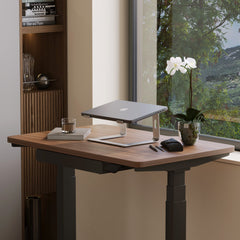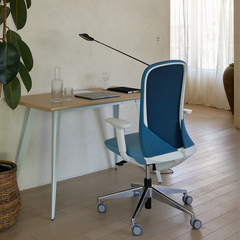Get 10% off your first order
Find the office furniture that’s designed to match your style, comfort, and needs perfectly. Subscribe
The Shape of Focus: How Furniture Design Influences Remote Work Habits

Visit quiz page to see how we makes it easy to create an inspiring workplace

The human mind interprets color as emotion before thought. In workspaces, the tones surrounding employees subtly influence their behavior, creativity, and endurance. Studies in environmental psychology confirm that hues in our visual field affect attention span, accuracy, and even physiological arousal. Within this context, furniture color becomes a crucial design decision, not just a stylistic choice.
Color signals the brain to adjust mood and readiness. Cool tones invite calm, while warm tones boost alertness and enthusiasm. Offices that employ balanced color palettes often see reduced stress and enhanced cognitive performance. When applied intentionally, chair colors serve as behavioral cues that help workers transition smoothly between focus and collaboration.
Visual ergonomics is about harmony between form and perception. The right hue complements posture and comfort, helping reduce strain. A workspace where color and ergonomics align supports the body and the mind equally, establishing a rhythm of sustained productivity and comfort.

A chair is the most interacted-with object in a workspace. It sits within the natural visual radius, influencing perception and focus every time a person sits down. The hue of a chair can impact how a person feels about their space, subtly altering concentration levels throughout the day.
Emotional ergonomics describes how aesthetic satisfaction and physical support merge to create comfort. A design like the Novo ergonomic chair with customizable hues demonstrates how thoughtful form and personalized color choices can elevate the sense of balance and productivity during long work sessions.
Extended screen exposure causes eye strain, and overly bright surroundings can amplify fatigue. Mid-tone shades with controlled saturation offer visual rest, reducing overstimulation while maintaining a lively atmosphere. Selecting a chair color that calms without dulling energy helps the mind stay alert yet comfortable.
Blue fosters concentration and emotional control. Its link to reliability and logic makes it ideal for analytical environments. Designers often recommend soft or muted blues to prevent coldness while maintaining composure. A seating option like the Muse chair in a tranquil blue finish can encourage clarity and centered thought, fitting well in both studios and home offices.
Green represents balance and natural restoration. When used in work areas, it reduces anxiety and refreshes attention after long stretches of focus. Pairing a green chair with plants or daylight promotes a sense of renewal and continuity between the indoor and natural environment.
Warm hues such as yellow or orange bring enthusiasm and spontaneity to group settings. They stimulate creative dialogue and optimism but should be balanced with neutrals to avoid overstimulation. These tones are best for brainstorming zones or collaborative workspaces where energy drives outcomes.
Dark neutrals ground the visual field, conveying authority and calm focus. They minimize distractions by absorbing excess light and setting a professional tone. The Onyx performance chair in graphite blends a refined neutral palette with ergonomic engineering, offering visual simplicity that sharpens concentration.
Light tones expand perceived space and promote clarity. They reflect natural light evenly, reducing shadows and mental clutter. The Seashell chair with its soft ivory shell illustrates how gentle brightness can amplify openness and serenity in minimalist settings.
Color does more than please the eye; it changes how comfort is perceived. Cooler tones tend to make spaces feel more breathable, while warmer ones suggest coziness. Balancing both creates a psychologically ergonomic environment where the worker feels physically supported and visually comfortable.
The concept of a safe and supportive workspace extends beyond posture. Research from the NIOSH ergonomic design guidelines highlights how environmental design can prevent discomfort and fatigue. Integrating this understanding with color decisions ensures a workspace that nurtures both wellbeing and efficiency.
Neutral foundations in office design act as visual anchors. Adding selective color accents—perhaps through chair fabrics or accessories—introduces controlled stimulation. This technique avoids overstimulation while allowing personal expression and visual energy.
Harmony between furniture pieces shapes visual rhythm. A desk and chair that complement each other in tone and texture can anchor the workspace mentally, helping users move naturally between tasks. Balanced contrast maintains interest without cluttering perception.
Contrast influences how the mind perceives depth and order. Pairing a light chair with a dark work surface creates grounding, while similar tones maintain cohesion. Combinations inspired by Urbanica’s contemporary desk collection demonstrate how thoughtful pairings can sustain focus and aesthetic harmony.
Workspaces today are highly personal, reflecting both professional needs and identity. Chair colors are a subtle but powerful way to express values, whether calm and deliberate or energetic and creative. Customization allows each person to align their environment with their desired workflow.
Customization becomes practical through solutions like Urbanica’s Build Your Bundle customization feature, enabling cohesive combinations of materials, colors, and ergonomic structures. Matching tones across multiple pieces supports visual balance and comfort consistency.
In larger offices, assigning distinct palettes to departments fosters intuitive organization. Calming blues in analytical teams and energizing yellows in creative clusters can improve group cohesion and reduce visual monotony across shared areas.

Personal associations with color vary. Individual experiences, culture, and personality affect how each person responds to specific hues. Recognizing this diversity helps avoid a one-size-fits-all approach to workspace design.
Employees who crave structure may prefer steady neutrals, while those needing inspiration lean toward brighter accents. Selecting a tone aligned with emotional rhythm enhances consistency in mood and attention throughout the day.
Exploring the Urbanica chair gallery provides an opportunity to match visual preference with ergonomic performance. Testing different tones and textures helps define a personal workspace aesthetic that feels both motivating and restorative.
Workplace design continues to evolve toward deeper personalization and environmental harmony. Future approaches are expected to prioritize sustainability, sensory comfort, and adaptable design that responds naturally to human needs rather than relying on excessive technology.
Designers increasingly integrate biophilic principles, blending natural materials with restorative color palettes. These choices reduce stress and encourage a connection to the living world even in modern, structured offices. As awareness of mental health in workspaces grows, color and ergonomics together will remain at the center of supportive design philosophies.
| Chair Color | Emotional Response | Ideal Environment |
|---|---|---|
| Blue | Calm, stable, focused | Offices with analytical tasks |
| Green | Refreshing, balanced | Creative or mixed-use work areas |
| Yellow | Energizing, social | Collaborative spaces |
| Orange | Stimulating, optimistic | Brainstorming zones |
| Black/Gray | Grounded, disciplined | Professional settings |
| White/Cream | Clean, open, reflective | Minimalist or compact offices |
Understand the function: Match hue to the nature of work.
Balance stimulation and rest: Alternate energizing and calming tones.
Respect personal association: Consider cultural and emotional ties to color.
Prioritize ergonomics: Ensure comfort and support remain central.
Maintain coherence: Keep palettes consistent across the workspace.
Choosing the right chair color is not a superficial detail. It is a strategic act of shaping the workspace around human psychology and wellbeing. When combined with ergonomic comfort, color becomes a silent collaborator in daily focus, creativity, and emotional balance. The intersection of science, design, and honest craftsmanship ensures that each shade chosen adds meaning and energy to the way people work.

The Shape of Focus: How Furniture Design Influences Remote Work Habits

Work That Flows: Designing a Home Office That Actually Works

Choosing a Chair for Hardwood or Tile Floors
Get 10% off your first order
Find the office furniture that’s designed to match your style, comfort, and needs perfectly. Subscribe
Leave a comment